Welcome to another weekend, after a week when I had to change three of the subjects that I started with for various reasons - either being unable to find a card, or the date not actually being correct on further examination. And a couple of these tied loose ends which I went back in and corrected on the other site too. In fact there were a few loose ends tied from the Cards of the Day as well, so a quick round of the things we did this week are as follows :
- Started adding more reference book data added to Kinney Bros "Military Series" (but this is a major job and not finished yet)
- Started adding the plain text version of the RB.126 British Trade Handbook amendments to its page (another major job, I have done four pages of seventy-two)
- Closed the book on Blue Band "History of London", altering the other blue back to a black one
- Used the black and white version of the Sunday Mail Junior Sports Club, the companion to the colour set we used as our Card of the Day for the 6th of October 2025.
- Wondered what it would be like if the Card Index and Gallery was split into sections rather than a long string to scroll down, and I have to say I find it a lot easier. Do you?
- Tried to sort out the Shell Australia listings and failed. They really need to be started from scratch. However we also had a bit of a discovery because right from the start Shell called them "Project Cards" and this means that if we just sort out another serpent, and use the Flora and Fauna from the first batch as a Card of the Day/home page for all the sets, things would be a lot less complex.
And now let us return you to our regular schedule....
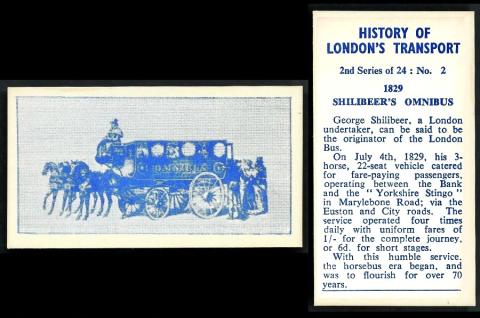
BLUE Band [trade : postage stamps : UK - London?] "History of London Transport" first series - blue (1954) 6/24 - BLU-100.b : BLV-1.b
Today in 1911 was a bit of a sad event, for it saw the last horse-drawn bus operated by the London General Omnibus Company, otherwise known as the L.G.O.C., on the streets of London and travel from London Bridge to Moorgate.
The L.G.O.C. had started up in 1856, with just a few buses, but within a year owned seventy-five per cent of all the buses in London. And though the Underground came along in 1863, there was, at first, some resistance to travelling on it, which the L.G.O.C. took full advantage of.
When this started to lessen, they used another ploy, or actually the truth, this being that the stations were quite far apart, often very much further than the bus stops were. Unfortunately, the trains were faster, so on long distances this was less important.
Then in 1870 along came the tram, which was actually cheaper than the omnibus, but was never much of a competitor, for it could only travel along the set lines which were carved into the road, and also trams were actually banned from the City and the West End of London.
The end for their horse bus was actually none of those things, the L.G.O.C. caused that all on their own, with a motorised bus, the "Type-B". This only needed a little maintenance, no hay, and no veterinary bills. And so it won out. By 1912, twenty of those new motor buses were being built every week.
However, as is often reported, this was not the last horse bus in London. For the Tilling Company, rival operators, who refused to give in and cede their routes to the L.G.O.C., operated their horse buses all the way through to the fourth of August 1914, and would have probably gone on longer, if War had not been declared on that day.
Our card is not an L.G.O.C. omnibus, nor a Tilling one, it is the first ever London bus, built in 1829. It also originated the term "Omnibus", the "Omni" part being Latin, and meaning "for everybody". The idea of having a multi passenger vehicle drawn by horses actually came from Paris, where their service had started in 1827, and it was a coachbuilder called George Shillibeer, working in Paris, who brought the idea across to London, and saw his first bus go out on the road on the fourth of July 1829.
Unfortunately his idea was easy to copy, and by 1834 he had been forced out of business by cut price competitors, who not only took his idea but his routes.
As for our set, it is one of the loose ends, as I had used both of the other colours elsewhere; and as the listing for the black back version, which comes first alphabetically, was a Card of the Day, for the 11th of December 2022, that became the home page for all three colours, plus a bonus, for there was actually a second series, which turned up just in time to be included in part four.
The three original sets are listed in our original British Trade Index part two as :
BLUE BAND Series
Packets of Stamps, etc. Cards issued in 1950s
- HISTORY OF LONDON`s TRANSPORT. Sm. 70 x 37. Front in a) black, b) blue, and c) red.Nd. (24) ... BLV-1
And there are but a few minor changes in our updated version of this work, which reads :
- HISTORY OF LONDON`s TRANSPORT - 2ND SERIES. 68 x 38. Nd. (24). Anonymous printed full text back. ... BLU-110
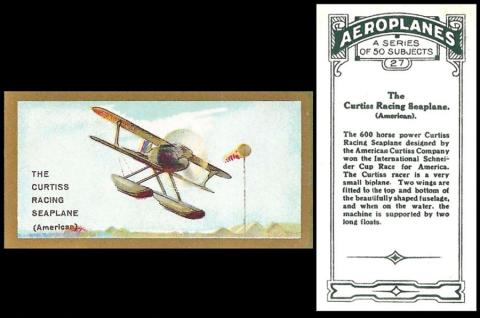
ANONYMOUS / British American Tobacco [tobacco : O/S] "Aeroplanes" (1926) 27/50 - ZB6-0 : W/122.B
This was the first substitution, I forgot I had written down "1925 Marx Bros. Cocoa-nuts, Boston stage premiere" and kept hunting, but it worked out okay because today, in another centenary, saw the Schneider Trophy held in America for the very first time since it began, in England, in 1913.
Our aircraft was one of three built specifically for that race, and she had siblings too, but slightly different. All were built by the Curtiss Aeroplane and Motor Company of New York, which, in 1929, would merge with Wright Aeronautical and be renamed the Curtiss-Wright Corporation. The first form, known as the Curtiss RC3-1, had wheels, and took off on land, whilst the second form, like ours, and known as the RC3-2, had large pods called floats which enabled it to take off from water. This did not make it into a flying boat though, the fuselage of which have a ship like hull which glides along in the water and aids propulsion - and as you can see on our card the fuselage of our aeroplane would always be proud of the water.
The winner was in one of these very aeroplanes, and he was also American, an Army Lieutenant called James Harold "Jimmy" Doolittle, who would go on to become famous, or maybe infamous, for the bombing of Tokyo during the Second World War. His speed was also the fastest ever, 232.57 miles per hour, the standing record, set at the 1923 Schneider Trophy, being 177.27 miles per hour - and coincidentally also set by an American, called David Rittenhouse.
Then on the following day Lt. Doolittle took her out for a spin and saw the speedo hit 245.7 m.p.h.
Now we have to say that we are not entirely sure that it is him flying this aeroplane. The front only says "The Curtiss Racing Seaplane (American)" - and whilst the back says "The 600 horse-power Curtiss Racing Seaplane designed by the American Curtiss Company won the International Schneider Cup Race for America." , it does not say that this is is the winning aircraft, and as we said earlier, there were two other R3C-2s, piloted by George Cuddihy and Ralph Oftsie in the very same race, though neither of them finished the course. But if we suspend our scepticism, we could say that this was the winning craft, piloted by Lt. Doolittle - and that would change everything as far as his "Rookie" card, which is universally supposed to be the 1933 Goudey Gum set of "Sport Kings".
By the way, the actual aircraft still survives, at the National Air and Space Museum at Washington Dulles Airport in Virginia - and not just survives, but still wears the same racing livery, and her number, "3", as she did on the day she won the Schneider Trophy.
This anonymous, British American Tobacco version appears first in reference book RB.21. published in 1952. They have it in the front index, twice, once under “Anonymous Issues (1) with letterpress on back”, which reads :
- Aeroplanes (1926) - Malta, Malaya... W/122.B
and once under “Wills – Overseas Issues”, which reads :
- Aeroplanes (1926) - Malaya ... W/122
Both these "W" codes direct us to the original Wills reference books, and it is actually in part IV, listed as :
122. 50 AEROPLANES. Fronts lithographed in colour, gilt borders. Backs in grey-green, with descriptive text. General Overseas issues, about 1925 ;-
A. Wills` name at base of back.
B. Anonymous backs.
Similar series issued by Bear and Player (titled “Aeroplane Series”.)
The Wills issue was also overseas, and is cited as being issued in New Zealand, Malaya, Malta. And it is only the Player version, also issued overseas, in New Zealand, Malaya and Siam, which is titled "Aeroplane Series", the Thomas Bear set was called just "Aeroplanes", and it too was issued overseas, in the Channel Islands, East Africa, the Far East and New Zealand. What is really odd is that all these versions were issued in 1926. I bet that led to some confusion!
In our original World Tobacco Issues Index, published in 1956, this anonymous version of the set is sent to the back of the book, under section 2 for "English Language Issues (1) with letterpress on the back", and sub sections 2.C for "issues 1919-1940"and b. "overseas issues through B.A.T.. Small size 67-68 x 35-36 m/m unless stated." It is first up in that section, described as :
- AEROPLANES. Sm. Nd. (50). See W/122.B ... ZB6-0
Look at that card code, ending in an "0", for I am almost certain that I have not seen any other “0” suffixes anywhere else, all the rest start at -1. So does this mean that our set was a late arrival, and quickly had to be slid into place above “Aeroplanes of Today” without needing to reset a large quantity of type? Anyone know?
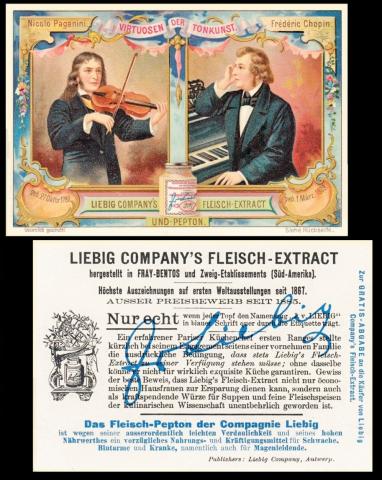
Liebig [trade ; meat extract : O/S - South America ] "Virtuosen der Tonkunst" / Musical Virtuosos (1899) Un/6 - F0585 : S.596
This was a last minute substitution for the 1925 launching of the USS Sequoia, which would later become the Presidential yacht. Try finding a card of that!
So we have Niccolo Paganini, born today, in 1782, in Genoa, the third child in a musical family, and three more children would follow him into the family.
His father worked at a chandlery, supplying and outfitting ships, but seems to have spent most of his time making and selling musical instruments, mainly mandolins, and also playing them in various hostelries and other venues by way of advertising his wares. The good thing about this was that music was always part of family life, and little Niccolo was taught to play the mandolin from the age of five. He seems to have played it well, and was given a scholarship to a local violinist, in fact several, all of which reported back, one after another, that there was nothing else they could teach him.
When the French invaded Northern Italy in March 1796 the family relocated to the country. It seems that it was a quick move as our man started to play the guitar, which suggests the mandolins had been left behind in the flight. They also seem to have been forced to find money fast, and both father and son held concerts, whilst his father found a job much like the one he had left behind. Master Paganini, aged just eighteen, also accepted the rather curious job of "first violin of the Republic of Lucca", a state in Tuscany - which actually meant he was not only the lead violinist in the orchestra, but had full responsibility for many other things - in fact this job is also known as a concertmaster.
However in 1805 the Republic of Lucca was taken by Napoleon, and given to his sister. This sounds a bad thing, but Master Paganini was a bit of a charmer, and he soon began a relationship with Napoleon`s sister, despite the fact that she was married. This lasted for ten years, and only ended after they had all moved to Florence. There are rumours that the husband found out, and that would certainly explain why for a few years Niccolo Paganini decided to go on tour rather than settle in one place, as well as completely avoid the limelight.
Then, in 1813 he gave a concert at La Scala in Milan. This seems to have made his name across Europe, and sent him off on another tour, right across from Vienna to Strasbourg, which lasted for four years - and he then continued with another tour of France and the United Kingdom, despite his health being in continual decline. We are not sure what was wrong with him, and probably never will, but we do know that in 1834 he was treated for tuberculosis in Paris and he decided to retire from touring. However he was too fond of the lavish lifestyle to really do that, plus in 1825 he had become a father, the result of a relationship with a singer, and so he got involved with a scheme to run a casino in Paris. This was a complete failure, and left him deeper in debt, so much so that he was forced to sell all his instruments, and not for their value, just at auction - or maybe they were even seized to pay those debts.
He then turns up in Marseille, in December 1838, and moved to Nice, where he was so sick that he was almost given the last rites, but he refused. However a week later, in May 1840, he died without them, and that caused all sorts of problems, because there had always been rumours and outright suspicions that he was in league with the Devil - so much so that the Church denied him a Catholic burial, and he was not buried at all for thirty five years.
Our card is the German version, titled "Virtuosen der Tonkunst", which seems to translate better to Musical Virtuosos than the given title of Musical Celebrities". However, the Italian version is titled "Celebrita Musicali", which fits the translation a lot better, and suggests that this was the first version to be catalogued.
Each card shows two people, and two of those cards show female musicians. The full cast list is as follows :
- Pablo de Sarasate / Franz v. Lizst
- Jos. Joachim / Hans v. Bulow
- Nicolo Paganini / Frederic Chopin
- Anton Rubinstein / August Wilhelmj
- Clara Schumann / Normann Neruda
- Annette v. Essipoff / Marie Soldat
By the way, I did check after typing this list, and it does appear that Niccolo used one or two "c"s in his name at will, so the card is not wrong after all.
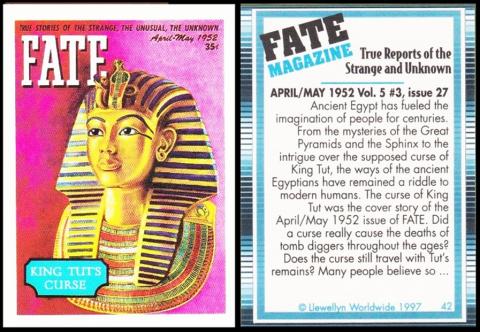
LLEWELLYN Worldwide [trade : publications : O/S - USA] "FATE Magazine Cards" (1996) 42/51
Ah now this is an interesting Centenary, as today in 1925 the coffin of Tutankhamun was unearthed. This was slightly under three years before the top of the entrance steps were revealed, which had happened on the fourth of November 1922. It then took them twenty-two days before they reached the antechamber where many of his belongings were held in what was thought would be eternally sacred storage.
The tomb was indeed thought by many to be cursed - and this was reinforced by several strange events, notably the death of Lord Carnarvon in April 1923. This did not stop the digging, it continued under the leadership of Howard Carter until several shauries with the newly partially independent Egyptian government stopped the work in February 1924.
That stoppage lasted for almost a year, which was only resolved when it was agreed that the bulk of the findings were to go to the Egyptian Museum in Cairo.
So it was not until 1925 that the group finally opened the stone sarcophagus of the boy-King Tutankhamun, to discover there were three coffins inside, two of gilded wood, and then one of solid gold, each smaller than the one before it. Then, inside that, they found the mummy, wearing the mask that has now become so famous.
This partially explains why card 11 of Wills` "Wonders of the Past", issued in 1926, uses only a statue from the antechamber, which was found "...before the sealed door to the innermost burial chamber..." and nothing at all about what they would find inside - because they had no idea at that time what was in there.
In fact it appears that the "Rookie" card of the actual mask did not come until 1986, when it was featured in Embassy`s "Wonders of the World". This predates card 27 of the 1992 Pro-Set "Guinness Book of Records", which is usually quoted as its earliest cartophilic appearance, by six years. However that card is notable, because the text is incorrect - it states that the mask was "..discovered by Howard Carter in Egypt in 1923..."
Our card was issued in 1996, by Llewellyn Worldwide, from a set of fifty cards featuring famous covers from "Fate Magazine", which was first issued in 1948 and aimed to expose the truth about aliens, and other paranormal events - less than a year after the events at Roswell, New Mexico, and the subsequent attempts at covering them up. In fact it could be said that "Fate" is entirely responsible for the growth of the belief in conspiracy theories.
In 1988, Llewellyn Publications, the issuers of this card, bought "Fate" magazine, and, in 1994, perhaps catching "X-Files-Fever" from the release of the television series of that name, it was enlarged to the size of a standard magazine, and printed throughout in full colour. Sadly "Fame" magazine was never mentioned in the series, as far as I know, but next time I watch them all again I will listen out, and confirm this later....
However in 2003 the magazine shrunk back to its original size, and in 2008 it went to bi-monthly - but at least it is still going strong as a printed magazine, and that, in these times, is quite a miracle.
And it also looks like Llewellyn Publications also make tarot cards and other occult goods, hence their interest in the magazine, one supposes.
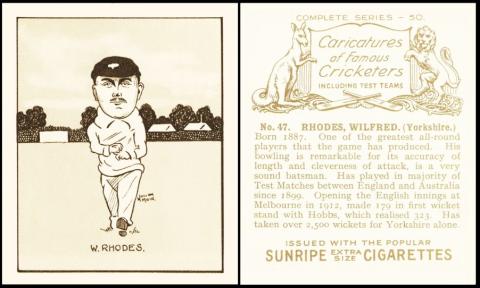
R. & J. Hill [tobacco : UK - London] "Caricatures of Famous Cricketers" - large size (1926) 47/50 - H46-52
This card is so light, I will have to sort that out. Actually this was not a substitution, the thing that I crossed out on my notes sheet turns out to be "Harrow Christmas Lights 5.45 p.m" and that turned out to be way too early, it is in November, which I ought to have realised at the time I wrote it down !
So here we have what we started with, today, in 1877, seeing the birth of Wilfred Rhodes, in Kirkheaton, Yorkshire, called on this card "One of the greatest all round players that the game has produced".
His family moved to a farm when he was way too young to remember them doing so, and he only went back to the Huddersfield area when he went to senior school. His love of cricket came from his father, who was captain of the Kirkheaton team and encouraged his son to play as much as possible, even mowing a pitch on the farm for teaching purposes; in fact before he even left school he had been joined up to the team, though he also took a job on the railways, as even his father knew it would be some time before he could become professional and get money from sport. Unfortunately he lost the job, when he contrived to ring the shift bell early so he could race to a match. After that he worked on a farm, but presumably not the family one, it is unclear, though "a farm" does not suggest "the farm" he lived at.
His skill at cricket was noticed fairly quickly, and he was recommended, as a professional player, to Galashiels Cricket Club in Scotland. It seems like the mention of turning professional far outweighed the fact that it was a long way from home. And he did not stay there long, only two seasons, before he was back in England again. It appears that he came back after applying for a job at Warwickshire County Cricket Club, but did not get that, so he joined Yorkshire instead, who were hunting for a player after losing one of theirs, a man called Robert Peel, who seems to have been rather a character. Despite our man getting the job, they did not play him until 1898, and he must have been an immediate success as soon after that he was asked to play for his country too. In fact he played almost sixty Test matches, from 1899 until 1930.
The First World War affected his career a bit, but he was not sent overseas, he was found work in a munitions factory. And several of the Yorkshire squad were killed or injured, which meant he easily retained his place. In fact they held the County Championship trophy from 1922 to 1925 without a break.
In 1929 he found himself on the England team to tour the West Indies, and he did debate whether or not to go, but in the end he did. However he was fifty-two years old, and found the tour rather taxing, the opposing side were all much younger and fitter, and though he performed really well he came home feeling his age. And he did say openly that was the reason why he decided to retire.
He then became a coach at Harrow School, but left in 1936; there is a rumour that he was rather irascible and critical with the boys, but he was also losing his eyesight, which he did his best to conceal. In 1939 he was told that his sight was too poor to allow him to serve in the forces or the home front, which he fought against, without success - though it did eventually lead him to a specialist who diagnosed glaucoma, a disease which we are still no closer to healing today, though it is also true that if it is diagnosed early it can be slowed down.
Sadly that did not happen to him, and he was completely blind by 1952, though he continued to attend cricket matches. And he died in 1973, aged ninety-five.
These caricatures were drawn by William Moir, and his name is on each card, somewhere on the front. However I have come up with nothing about him at all, which makes me wonder whether a cricketing collector may know of him better than I. He is not even mentioned in our original reference book to the issues of R. & J. Hill, which catalogues the set twice, as :
- 1926. 50. CARICATURES OF FAMOUS CRICKETERS, including Test Teams (titled series). Size 2 3/4" x 1 1/2" approx. Numbered 1-50. Fronts, printed by offset in two colours, brown marginal lines and white margins. Subjects titled. Backs, printed in brown, with descriptions and "Issued with the popular Sunripe Extra Size Cigarettes." No maker`s name appears
- 1926. 50. CARICATURES OF FAMOUS CRICKETERS, including Test Teams (titled series). Similar to the above and the same subjects, but size 3 1/8" x 2 5/8".
Both sets printed by Ripley & Co., London
By the time of our original World Tobacco Issues Index, the set is listed as :
- CARICATURES OF FAMOUS CRICKETERS. Brown. Nd. (50). "Sunripe" brand issue. Size (a) small (b) large ... H46-52
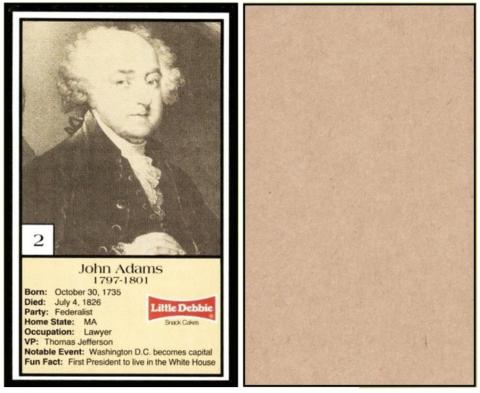
McKEE Baking Company [trade : cakes : O/S - Tennessee, USA] "Presidential Portrait Cards" (1992) 2/39
Here we have John Adams, born today in 1735, and, as the first born, the inheritor of his father`s forename. He was born on the family farm at Braintree, Massachusetts, where his family were of pretty high standing, his parent being the Deacon at the local Church. I actually wondered about the name Braintree, and I was right, for further investigation discovered that his great-great-grandfather, Henry Adams, arrived in Massachusetts from Braintree, Essex in approximately 1638.
When our John Adams was sixteen he went to Harvard College, ostensibly to follow his father into the Church, though it seems likely that this was only the plan of his father and our man decided to be a lawyer. He was temporarily swayed by the French and Indian War, seeing the local men marching off in their uniforms, but by the end of 1756 he had found himself a job, as a trainee lawyer to James Putnam, who would become Attorney General for the whole of Massachusetts.
By that time John Adams had fallen in love with the girl he would always regard as the love of his life, but lost her to another. He then married his third cousin, about whom he freely admitted, towards the end of his life, that though he did not think much of her at first, he grew closer to her in time. They were married in October, 1764, and moved to the family farm, which was now empty, his father having died. It sounds like this was a fairly strong factor in the marriage as well - but the couple did have six children between 1765 and 1777, the last of which was stillborn, after which no other attempts were made. In fact it seems likely that they had planned only four, but the fourth, Susanna, died when she was just a year old, and that led to them having the other three.
Inevitably the legal side of his life led to John Adams getting more and more involved in higher profile cases and into politics. In November 1777 he was named Commissioner to France, going out with two men, Arthur Lee and Benjamin Franklin, who we quite coincidentally featured as a Card of the Day only this week. He also took his ten year old son, John Quincy Adams, who was showing a talent for the law (and would become the President of America himself, from 1825 to 1829.) After France, John Adams travelled to Holland as the Ambassador to the Dutch Republic, and then, in 1785, to Great Britain, where he became the first ever American Ambassador.
All these things were taken into account when he was voted in as George Washington`s Vice President in 1789. George Washington actually held the post for two terms, but after that he announced he would not stand a third term. There was an election, Thomas Jefferson against John Adams, which our man won by just three votes.
Despite what this card says, most of John Adams` Presidency was spent at his home in Massachusetts, with only odd visits to the President`s House in Philadelphia, which was then the seat of office. And he only moved into the not-quite completed President`s Mansion in Washington on November 1st 1800, only staying until he lost the next election, to Thomas Jefferson, on February the 17th 1801 - though in fact he stayed for about a fortnight more, packing, and clearing up.
He continued to practise law, and look after his family. His wife died, of typhoid fever, in October 1818, whilst her son was campaigning to become President. Then, on July the fourth, 1826, the fiftieth anniversary of the adoption of the Declaration of Independence, John Adams died of a heart attack at home. He never knew that Thomas Jefferson had already died, at midday, on the very same day. Spookily, the fifth President, James Monroe, also died on the fourth of July, 1831
These cards were printed on the backs of the packaging, and were designed to be cut out and collected.
There are a few curious facts about the set - firstly yes, thirty-nine is an odd number, but it is for a simple reason, that being that Grover Cleveland was President twice but only appears on one card. And we know some of the cards were reprinted at least three times - as so far we have found
- card 5 (James Monroe) with the background to the text box in blue or orange.
- card 7 (Andrew Jackson) with the background to the text box in yellow, pink or orange.
- card 11 (James A Polk) with the background to the text box in pink or grey
- card 32 (Franklin D. Roosevelt) with the background to the text box in pink or grey
- card 40 (Ronald Reagan) with the background to the caption box in orange or grey
The card which everyone seems to want shows Richard Nixon, but this is not a colour variation, the text is different on the last line, which either reads : "Fun Fact : First President to attend space launch" or "Fun Fact : Only President to resign from office".
And I guess that sums up American Presidents pretty well, some of them being remembered for all the good, and clever, things they did - and others not...

H. POPPLETON & Sons Ltd. [trade : sweets : UK - Lincoln] "Wembley Exhibition Series" (1926) Un/?
And now to our closing ceremony, which is also a centenary, for today in 1925 the British Empire Exhibition closed for the very last time.
This was the end of the second, additional season, which had never been intended. According to the press of the time it was reopened purely because of the grand success of the first year, during which eighteen million visitors flooded through the turnstiles. This was not the truth, it actually reopened in an attempt to make up some money, the 1924 season not having even broken even against the outlay. However the second season never really took off and the estimates are that under nine million visitors actually went.
Even the Prince of Wales, the future Edward VIII, President of the organising committee, who had presided over the opening ceremony, did not go to the closing one, he left his brother, the future George VI, to deliver the address and declare all fun over.
To be fair, not much at Wembley was that different, though the organisers used the slogan “The Same Empire but a New Exhibition” in their advertising.
The Amusement Park had new attractions, and there were new shows at the Empire Stadium - a circus and a display called “London Defended”, with aircraft and searchlights, which was all a bit too like the war the people were trying to forget.
There had also been some renaming of the large pavilions, The Palace of Engineering was now the Palace of Housing & Transport, and Burma decided not to attend, so Schweppes filled its vacated carved wooden Burmese palace, though as a bonus they were allowed to overprint the left over Burma postcards with "Schweppes".
Even the left over souvenirs can be found re-struck, or re-transfer-red with a "5" where a "4" had been, to recoup their losses, and maybe to save making more.
I say this and it sounds like I am being disparaging, but I am not.
Without the exhibition we would never have seen the great expansion into the North West suburbs, and there would have been no football at Wembley.
And I much regret not being able to go in person, and see the wonders that can be viewed on all manner of cards.
Now this card is but a stopgap and will be replaced. The scanner did not work so this is a photo off my phone, and the top half of the back was in the light whilst the rest was in the shadow. Tomorrow in better light I shall try again, or the scanner may have decided to perform. But it is a really unusual card, and it is great at last to show it.
As for H., or Henry Poppleton, he was born in Hull in 1829, but his family relocated to Lincoln very soon after. It seems that this was because his father, William, a shoemaker, got a better offer of work or premises than he currently had. He hoped that Henry would follow in his footsteps, but he did not want to.
Henry was not sure what he wanted to do but he was apprenticed to a baker, and he eventually took over the shop. He also married the baker`s daughter, but not until 1851, after he had the shop in his name.
After that, but not long after, he appears as "baker and biscuit maker". It appears that the biscuits sold well, and he thought he would have a go at sweets, starting with butterscotch, caramels, and cough drops.
His wife gave birth to her first child, a son, in 1855, and she would have seven more, four sons and four daughters in all. Three of his sons were in the company name, his first, George, Henry William (born in 1861) and Frederick Lister (born in 1869). His second son, Charles Herbert (born in 1857), was not interested in business, and joined the Church - though actually Henry himself was a Methodist minister, so I think he may have been pleased with that.
Henry Poppleton died on 21st September 1912, and the sons kept the business going until 1936.
This week's Cards of the Day...
may have been slightly early, but started to discuss the reasoning behind the moving of those clocks back and forth, and the end of British Summer Time.
Saturday, 18th October 2025
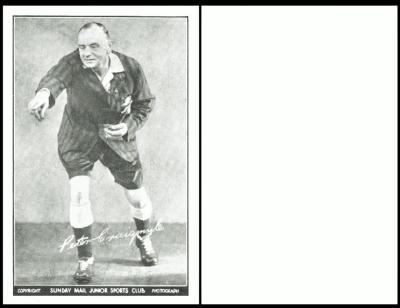
This is the companion to the coloured version which we featured as our Card of the Day for the 6th of October 2025.
As to why, well time is very important to a referee, which is why many of them have two watches, one which they run the match with, and one which keeps an eye on the actual time. According to a reader, time stoppages come into play during substitutions, whilst players are being checked out after injuries, when players cannot play on due to injury and must be removed from the pitch, whilst the referee "gives discipline" to a certain player or team, or if he thinks that players or teams are wasting time unnecessarily.
Our man would have known of all these, but he would have been blissfully unaware that one day the referee would also have to compensate for the time taken to collaborate with a Video Assistant Referee (or VAR), who watches the footage on video from an assortment of angles before deciding which player needs the penalty and why - and also for the time that the player argues the fact thereafter.
Peter Craigmyle is regarded as one of the greatest referees ever, and yet his choice of career was only due to the fact that he broke both his legs in an industrial accident in 1916, and was unable to play football thereafter. In fact we can thank jimmy Phillips, the first ever manager of Aberdeen F.C., for the nudge, for he suggested that our man could become a referee and be just as involved with the game. The club was also kindly, they welcomed him to train with the players, and they would have liked him to become a director, but he never did, he always said he did not have time, for he also owned a sports shop, on King Street, which supplied all the kit to the team
He was born with the year, on the 1st of January 1894, and he lived until 1979, during which time he became the first referee to have a regular weekly radio programme, the first referee to officiate at a game inside a prison, the first to travel to a game by airplane, and only the second to ever publish an autobiography, "A Lifetime of Soccer" in 1949. And he did not retire until he was fifty-six years old.
This set appears in our original British Trade Index, but not until part four. They are part of a larger group, including other coloured cards which we featured as our Card of the Day for the 6th of October 2025.
Our section of the listing reads :
- The Sunday MAIL
Scottish Sunday newspaper. Cards issued about 1950.
Scottish Footballers (A). 142 x 90. Two styles, captions as facsimile signatures. Club names do not appear on the cards but are added in parentheses in the listings ... SURR-1
- 1. Inscribed in panel at base "Sunday Mail Junior Sports Club", see Fig.SURR-1.1. 40 known
A. Picture in black and white, words "Copyright" and "Photograph" in capitals
B. Picture in colour, words "Copyright" and "Photograph" in upper and lower case letters
1. B. - George Aitken (Third Lanark)
2. A. - Archie Baird (Aberdeen)
3. B. - Bobbie Brown (Rangers)
4. A. B. - Jim Cowan (Greenock Morton)
5. A. B. - Sammy Cox (Rangers)
6. A. - Peter Craigmyle (Referee)
7. A. - Johnny Deakin (St Mirren)
8. A. - Jimmy Duncanson (Rangers)
9. B. - Bobby Evans (Celtic)
10. A. - Torry Gillick (Rangers)
11 .A - John Govan (Hibernian)
12. A. - Billy Honliston (Queen of the South)13. A - Wilson Humphries (Motherwell)14. A - Jimmy Inglis (Falkirk)
15. B. - R. Johnstone (Hibernian)16. A. - Jacky Law (Queen of the South)17. A. - David Letham (Queens Park)18. A. - Alex Linwood (Clyde) - Fig. SURR-1.119. A. - Hugh Long (Clyde)20. A. B. - Ian McCall (Rangers)21. A. - Ian McMillan (Airdrieonians)22. A. - John McPhail (Celtic)23. A. - Jimmy Mallan (Celtic)24. B. - Jas Mason (Third Lanark) - as No.9 in (2)
25. A. - Willie Paton (Rangers)26. A. - Tommy Pearson (Aberdeen)27. A. - W. Penman (Raith Rovers)28. A. B. - Willie Redpath (Motherwell)29. A. - Laurie Reilly (Hibernian) - different picture to below
B. - Laurie Reilly (Hibernian) - different picture to above30. A. - Archie Shaw (Motherwell)31. A. - Davie Shaw (Hibernian)
32 B. - Gordon Smith (Hibernian) - as No.11 in (2)33. A. - Billy Steel (Greenock Morton)
B. - Billy Steel (Dundee)34. A. B. - Willie Thornton (Rangers)35. A. - Charlie Tully (Celtic) - different picture to below
B. - Charlie Tully (Celtic)- different picture to above
36. B. - Eddie Turnbull (Hibernian)37. A. B. - Willie Waddell (Rangers)38. B. - Jimmy Walker (Partick Thistle)B. - Geo. Young (Rangers) - different picture to above
39. A. B. - Willie Woodburn (Rangers)
40. A. - Geo. Young (Rangers) - different picture to below
- 2. Without the inscription "Sunday Mail Junior"... See Fig. SURR-1.2
The cards are anonymous with plain backs. 22 known :
1, Bobby Baxter (Hearts)
2. Gordon Bremner (Motherwell)
3. Bobby Brown (Rangers)
4. Hugh Brown (Partick Thistle)
5. Jimmy Brown (Hearts)
6. Billy Campbell (Greenock Morton)
7. Booby Morton (Falkirk) Fig Surr-1.2
8. Pat Daley (Hamilton, Morton & Clyde)
9. Jerry Dawson (Falkirk)
10. William Findlay (Rangers)
11. Bobby Flavell (Airdrieonians)
12. George Hamilton (Aberdeen)
13. Ian G Harnett (Queen`s Park)
14. Jackie Husband (Partick Thistle)
15. Sammy Kean (Hibernian)
16. Johnny Kelly (Third Lanark)
17. Willia Kilmarnock (Motherwell)
18. Jas Mason (Third Lanark)
19. Willie Miller (Celtic)
20. Jackie Oakes (Queen of the South)
21. John Shaw (Rangers)
22. Gordon Smith (Hibernian)
There are probably lots of errors above, as they were taken from the signatures, which are never easy to translate. I already know that "Honliston" is wrong for card 12, the player`s name was Houliston
In our updated British Trade Index it is slightly different, and they appear as :
- SUNDAY MAIL JUNIOR SPORTS CLUB. 142 x 90. Captions appear on picture as facsimile autograph, or in roughly printed capitals. Two printings. Unnd. (89 known). Plain back. See HS-110 ... SUN-250
1. B&W, words "Copyright" and "Photograph" in capitals.
And some time I will get round to tapping in that list too.
Sunday, 19th October 2025
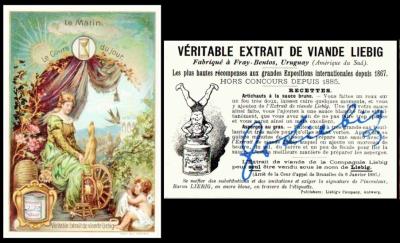
So here we have the morning, which will actually be brighter earlier, because the hour has moved to light`s advantage.
This card is an especially good illustration of that, for the dark above the curtain is giving way to a hazy blue.
This set is a very popular one, and beautifully drawn. The cards of the dawn. the morning and the night have a curtain, like our card, whereas noon and afternoon are given branches and leaves, and the evening has conifers and a sunset. Each has a lady and a cherub, but not the same lady and not the same style of costume.
The cards in the French version are :
- L`Aurore [dawn]
- Le Matin [morning]
- Midi [noon]
- Apres-Midi [afternoon]
- Le Soir [evening]
- La Nuit [night]
It is also available in Italian, as "Il Corso del Giorno", and in German. as "Des Tages Lauf".
Monday, 20th October 2025
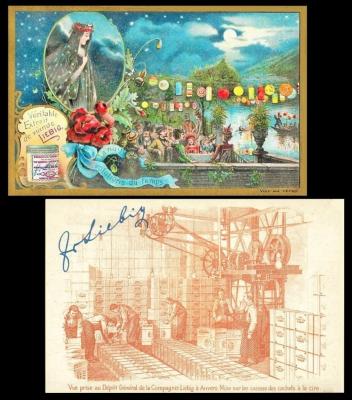
This card gave us the darkness at night, an extra hour all at once - and though at first we try to rally ourselves, as the people on this card are doing, but then we kind of give up and stay indoors.
To some extent our ardour for the great outdoors is dependent on the weather, for though we can indeed wrap up against the cold, few of us, not even dog owners, really want to go out and wander in the pouring rain
This set was issued in France, Germany, Holland, and Italy, but I only have the title of the French version which we feature today. I suspect that the Dutch may be "Evolutie van de Tijd", with the German as "Evolution der Zeit", and the Italian "Evoluzione del Tempo". However I have drawn a blank online by putting any of those terms in.
Curiously the make up of the set are the four seasons, plus the day and the night. The latter pair have blue sashes with the titles in and the "E" of "Evolutions" is not very easy to see , so if you are short one or both of those try looking for them online as "Volutions du Temps" and you could well be lucky.
Another little touch, which you may not have even noticed, is that on top of the sash there perches a bird - or a group of birds.
In addition, the cards in this set have a very unusual back, a scene, in sepia, and each card has a different back - covering four different views and stages of the packaging line, and then taking the stock off in carts and wheelbarrows,
- Le Printemps [springtime - rinsing the pots]
- L`Ete [summer - sealing the pots]
- L' Automne [Autumn - weighing and corking]
- L`Hiver [winter - the product on the way out of the works]
- Le Jour [the day - putting the product in pots]
- La Nuit [the night - packing the product in cases]
The order of the backs suggest that I have this in the wrong order, and maybe I have. They read better as Le Printemps, Le Jour, L`Ete, L` Automne (or maybe even these two reversed), Le Nuit and L` Hiver.
Tuesday, 21st October 2025
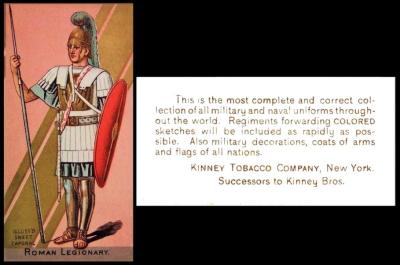
The story of adjusting time on a seasonable basis is said to have started with the Romans, whose water clocks had different measurements for different months of the year - measurements which varied quite considerably, dropping down to forty-four minutes by the winter solstice then rising to seventy-five minutes by the summer one.
However, adjusting the hours had actually been common practice before that, just not quite so regulated. All they had done was to split the light hours of the daytime into twelve sections, each becoming progressively longer during spring, and shorter during autumn.
Until such time as we use a card which has the numeral "7" on the front this will be the home page, containing all the information on all the sets we have not yet featured.
In our original World Tobacco Issues Index they are described as :
- MILITARY SERIES (A). Sm. 70 x 35. 622 known. See ABC/224 and X2-224. Ref. USA/224. ... K32-14
- Coloured Background Types.
1. Inscribed "7" on front. Unnd. (50). Back (a) "Notice" (b) "This is.."
2. Inscribed "8" on front. Bkld. (50) - our set
3. Inscribed "9" on front. Bkld. (30)
4.. Style as (1)-(3) without numeral. Unnd (50)
5. Foreign 1886 Types. Unnd (50)
6. Remainder of Coloured Background Types. Unnd. (26)
- Plain White or Lightly-Coloured Background Types. Unnumbered.
7. U.S. Army and Navy (51)
8. U.S. State Types (85)
9. U.S. and Foreign Types (60)
10. England and N.G.S.N.Y. (50)
11. Foreign 1853 Types (50)
12. Foreign Types 1866 (50)
13. Remainder of Plain Background Types (20)
The listing under X.2/224 is even longer, but lets see how I do. I will say that they use numbers, which are not on the cards, but I will insert the actual card titles with each section on its particular page, whilst here, which will one day be the page for group 8 alone, I will do just that and add the titles of the cards, :
- X.2/224. MILITARY SERIES. (A) Small size. Front in colour. Backs printed in brown. Issued by Kinney. Unnumbered series, 622 subjects. Cards are sometimes found overprinted on back with names of tobacconists, etc. the subjects are listed on pages 13-23 of the American Book of Checklists; a summary of the 13 sub-sets, together with the numbers of the subjects in each sub-set follows. Front "styles" refer to the illustrations in Fig. X.2/224-A, back references to the illustrations in Fig. X.2/224.B
I. COLOURED BACKGROUND TYPES
1. Front in style A-D, inscribed with numeral "7". This is "Collection No.7", but no list of subjects appears on the backs. Two back designs (i) Type 1 ["NOTICE. Beware of Counterfeits and Imitations"] (ii) Type 5 ["This is the most complete" without the offer to include Military Decorations etc]. Series of 50, as follows : No`s 77, 78, 82, 85,95, 103, 105, 145, 157, 110, 213, 218, 221, 222, 223, 249, 250, 251, 253, 254, 258, 260, 261,263, 264, 265. 267, 269, 271, 272, 273, 274. 280, 281, 282, 301, 311, 312, 357, 401, 476, 496, 501, 561, 572, 613, 616, 618, 619, 621
2. Front in style A-D, inscribed with numeral "8". Back as Type 2 [a list of all the subjects], but inscribed "Collection No.8". There are minor differences between captions on fronts and list on back. Series of 50, as follows : Nos. 1, 2, 88, 91, 102, 104, 106, 107, 140, 206, 220, 247, 344, 347, 356, 360, 365, 367, 368, 369, 371, 372, 382, 387, 398, 400, 408, 452, 453, 454, 455, 492, 494, 497, 498, 499, 500, 525, 526, 581, 597, 603, 604, 610, 612, 614, 615, 617, 620, 622.
3. Front in style A-D, inscribed with numeral "9". Back 2 [a list of all the subjects], but inscribed "Collection No.9". Series of 30, as follows : 83, 86, 162, 214, 215, 219, 237, 241, 252, 255, 266, 276, 284, 361, 373, 376, 383, 384, 385, 388, 396, 397, 410, 591, 592, 593, 594, 595, 596, 611.
4. Front in style A-D, but with no numeral. Back 5 ["This is the most complete" without the offer to include Military Decorations etc]. Series of 50, as follows : 3, 79, 80, 93, 98, 100, 165, 171, 204, 205, 245, 257, 259, 262, 270, 278, 287, 308, 309, 346, 355, 358, 364, 395, 412, 450, 451, 456, 457, 458, 479, 480, 481, 495, 527, 528, 576, 583, 584, 585, 586, 587, 588, 589, 590, 598, 599, 600, 601, 602
5. Front in style E, Foreign (i.e. non-USA), types, inscribed 1886, Name in white panel at base. Back 5 ["This is the most complete" without the offer to include Military Decorations etc]. This group is also found in a variety with the coloured background omitted. Series of 50, as follows : Nos. 297, 298, 302, 414, 415, 417, 421,423, 429, 430, 431, 432, 436, 437, 463, 465, 467, 468, 469, 470, 472, 482, 483, 487, 529, 530, 531, 532, 533, 535, 536, 540, 541, 544, 545, 550, 552, 553, 554, 557, 559, 563, 567, 568, 569, 570, 571, 573, 574, 575.
6. Remainder of the coloured background types. Includes 18 continental soldiers in style of F, with back 4 [as back 5 but continuing with "Also Military Decorations, Coats of arms and Flags of all nations"]. 3 Vatican types, and 5 Decorations. A few are found with white backgrounds. Series of 26, as follows ;- Nos. 4, 5, 6, 7, 8, 9, 10, 11, 12, 13, 14, 15, 16, 17, 18, 19, 20, 21, 473, 478, 486, 605, 606, 607, 608, 609.
II. PLAIN BACKGROUND TYPES
7. Font in style G. U.S. Army and Navy Types. A few have light coloured background, and some are found in a variety with fine red dotted background. Back 5 ["This is the most complete" without the offer to include Military Decorations etc].. Series of 51, as follows ;-
do note that these lists are being entered whenever I have time. And the illustration may wait until I can find the original.....
By the time of our updated World Tobacco Issues Index this listing has been altered to :
- MILITARY SERIES (A). Sm. 70 x 35. 622 known. Cards exist overprinted in black on back "M. B. Weidler - 31 West King Street - Cigars - Tobacco" and also overprinted on front "Smoke Le Flor de Curtis - Most Popular 10 cent Cigar". Ref. USA/224. ... K524-240
- Coloured Background Types.
1. Inscribed "7" on front. Unnd. (50). Back (a) "Notice" (b) "This is.."
2. Inscribed "8" on front. Bkld. (50)
3. Inscribed "9" on front. Bkld. (30)
4.. Style as (1)-(3) without numeral. Unnd (50)
5. Foreign 1886 Types. Unnd (50)
6. Remainder of Coloured Background Types. Unnd. (26)
- Plain White or Lightly-Coloured Background Types. Unnumbered.
7. U.S. Army and Navy (51)
8. U.S. State Types (85)
9. U.S. and Foreign Types (60)
10. England and N.G.S.N.Y. (50)
11. Foreign 1853 Types (50)
12. Foreign Types 1866 (50)
13. Remainder of Plain Background Types (20)
Wednesday, 22nd October 2025
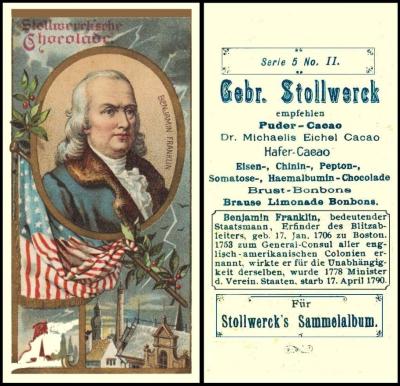
We move on now to Benjamin Franklin.
He was a keen exponent of making the most of the natural light, and is often connected with being the person who suggested moving the clock to get more light in the mornings. However, there are a couple of common misconceptions about this.
First of all, it is said that he wrote the slogan "Early to Bed and Early to Rise makes a Man Healthy, Wealthy, and Wise", but this is not only incorrect but undeniably proven by the fact that it first appeared in a book called "Paroemiologia Anglo-Latina", by John Clarke, which was printed in 1639, whilst Mr. Franklin was not born until the 17th of January 1706. However he liked the saying, and was very fond of using it, and probably most of his contemporaries had never heard of Mr. Clarke, let alone read his book. In fact what happened was that Mr.Frankin included the phrase in one of the book he printed and published on an annual basis, for twenty-five years, by the name of "The Poor Richard`s Almanack". This roundelay of little ditties and witticisms, and snippets on the weather, and predictions on the future, contained probably eighty-per cent of other people`s phrases, if not more, with the words slightly changed either in order or by swapping one word for another that meant the same. He also hid behind several pseudonymous writers and editors, starting with "Richard Saunders, Philomath", who "wrote" the first edition ever, published on the 28th of December, 1732. But that adds a layer of confusion, for it means that the general public would not have connected Mr. Franklin with the phrase at the time, the connection must have come later, and presumably closer to our time.
The second connection comes through his publishing a letter in the "Journal de Paris" in 1784, whilst he was an American Envoy to that city, which said that the residents of Paris ought not to waste money on candles when they could get out of bed earlier, as soon as the sun comes up., and use the time to work, then just go to bed when darkness came. This was a fairly reasonable thought, but the letter then went off on a rather strange tangent, asking the governments to get involved, to levy a heavy tax on candles and window shutters, and and to start the practise of waking everyone up by firing cannons and ringing church bells at the time the sun came up.
Unsurprisingly, none of this was ever seriously considered.
As for the third connection, it involves his time management schedule, which divided every day, irrespective of whether it was a weekday or a weekend one, into six blocks of time, and it started at the crack of dawn, rising with the sun, with personal hygiene, breakfast, and setting that day`s schedule of what he intended to accomplish on that day. Then for four hours either side of dinner at midday, he simply wrote "work", but he knew exactly what he was going to do when he sat down, he had planned it just that morning. And then at 6 p.m. he would lay down his tools, have supper, and pleasure, and then, when the darkness of the night started to prevent those things, he would go to bed. And after reading this, you do have more of an understanding of his rail against the Parisians, who laid so long abed, for he knew, full well, not just how more productive their lives could have been if they began it earlier, but how much pleasure they could have fitted in at the end of the day when all their work was put to bed.
As far as cards, it is universally agreed that Benjamin Franklin`s "Rookie Card" was issued in 1887 with "Lone Jack" Cigarettes, as part of the set called "Inventors and Inventions" (N.365). Our card was issued a decade after that, in a set which consists of
- I - Johann Gutenberg
- II - Benjamin Franklin
- III - James Watt
- IV - Werner v. Siemens
- V - Philipp Reis
- VI - Thomas A. Edison.
Most of these are quite well known but two may stump some of you.
Ernst Werner Siemens was born in Germany in 1816, but did not add the von which is represented by the "v." on the card until 1888, when he was in his seventies. He was a massive exponent of electricity and applied it to public transport as well as an electrically powered car. And his name lives on with the Siemens business today.
Philipp Reis was also born in Germany in 1834 and became the science master of the Institut Garnier, a boys boarding school near Frankfurt. And in 1860 he invented a way of communicating by wire from one classroom to another. It did work, and he actually exhibited it at a meeting of the Physical Society in 1861. However it seems that it was regarded as a mere trifle, too insignificant to be considered as part of science, and constructed of simple parts that anyone had laying about their works, hardly an invention at all. But some people now regard him, rightly, as the father of the telephone.
Thursday, 23rd October 2025
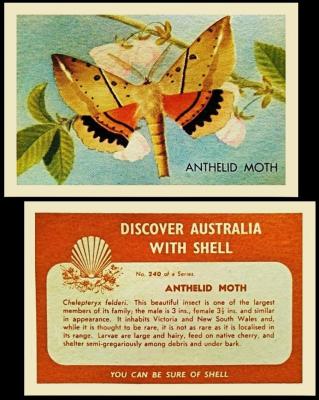
You are undoubtedly wondering what this moth has to do with the clocks going back and forth, so let me tell you the tale of George Vernon Hudson, a Londoner, born on the twentieth of April, 1867, who moved to New Zealand at the age of fourteen, with a growing collection of insects.
In New Zealand he worked on a farm and then at the Post Office in Wellington, where he rose to become the Chief Clerk. After work he would go out in the countryside as far as he could and study insects, but every year, with sadness, he would have to stop earlier and earlier due to the fading light, until it got to an time that it was dark even before he left the Post Office. This was even more of a nuisance after 1892, for in that year he had seen his book published, "An Elementary Manual of New Zealand Entomology - being an introduction to the study of our Native Insects".
He worked on a theory for some time, and in 1895 he presented a paper to the Wellington Philosophical Society proposing that the clocks be moved, by two hours, in order to give more natural light at night. Although the idea was met with some support, he thought that insufficient, and in 1898, the same year that his second book, "New Zealand Moths and Butterflies (Macro-Lepidoptera)", was published, he delivered another paper. However, it seems that even this did not inspire any action, and by then he was working on a third book, "New Zealand Neuroptera" (may-flies, dragon-flies, caddis-flies, and the like), which was published in 1904.
In 1907, almost certainly because of his books, he was part of the research team of the Sub-Antarctic Islands Scientific Expedition. Then in 1919 he was made the first ever "Fellow" of the Royal Society of New Zealand; and he was awarded the Hector Memorial Medal in 1923 and the Hutton Medal in 1929, both for his research in zoology.
There is a strange coincidence though, because in 1933 he was the joint first recipient of the Thomas Kay Sidey Medal - the other winner being Ernest Rutherford. Mr. Sidey had died earlier that year, he was a politician, but he was also a great advocate of daylight saving time, and had put forward a Private Member`s Bill that requested putting the clocks forward by one hour in summer every year from 1909. It was very nearly passed in 1915, and then passed in the House of Representatives in 1926 only to fall at the hearing before the Legislative Council. However it was finally approved, as the Summer Time Act 1927.
Not just that, but the medal was endowed from funds collected to commemorate the act becoming law. It seems that there was no connection to zoology, so Mr. Kay must have just remembered Mr. Hudson - or maybe they had stayed in touch without any fuss.
By the way. Mr. Hudson's collection of insects is still preserved in the Museum of New Zealand Te Papa Tongarewa, which was founded, in 1865, as the Colonial Museum. It is the largest collection in New Zealand and also still present are the three hand-written volumes belonging to Mr. Hudson, complete with his own, self-originated, coding system
And now an apology, for this moth is not amongst those books, it is only native to Australia. so we may have to change the card. And if anyone has a New Zealand moth from a set we have not featured before, please let us know!
The group, which may change, is listed in our original Australian and New Zealand Index, RB.30, published in 1983, under SHELL (Service Stations). It comes under group 1, "Issues in Australia - Inscribed "Shell" without full name", and our section is listed as :
- Discover Australia with Shell. 76-78 x 51. Four sets of 60. ... SH6-1.
1. Nos. 1/60, back vertical. Flora and Fauna. Two pictures at No.5 (Kangaroo Paw) - (1) flower with three stems (2) flower with two stems. Few copies of album known - it was probably withdrawn as it contains errors so that all cards do not fit the places provided.
2. Nos. 61/120, back horizontal. Shells, Fish and Coral
3. Nos. 121/180, back horizontal. Birds
4. Nos. 181/240, back horizontal. Butterflies and Moths
Using this set has led to a bit of a discovery, for though we title these four sets as "Discover Australia with Shell", and this is also on the cards, they actually fitted into an album which was titled as a "Project Card Album", and we know it is not a general album used wrongly because beneath the main title on the front is actually printed "Butterflies and Moths". However, this raises an interesting question, because in our Australian and New Zealand Indexes the cards are split into three groups, starting with four series of "Discover Australia with Shell", then two series of "Picture Cards" and only finally three series of "Project Cards". But looking at the album it appears that all the cards were intended to be Project Cards.
Friday, 24th October 2025
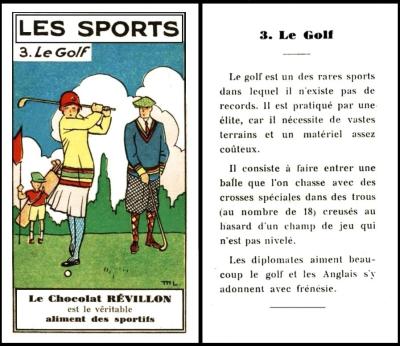
Golf brings us to William Willett, of Farnham in Surrey, who followed his father into the building trade. In their day, to own a "Willett" house was really something, and business was booming, so much so that the Willetts had a large estate in Chislehurst, Kent, with a stable.
Most of all William Willett loved golf, hence our card, though he hated having to race a round in the winter months, or, worst of all, to cut one short at dusk in order to get back to the clubhouse whilst he could still see it.
He pondered on this, and in 1907 he self-published a booklet called "The Waste of Daylight". We do not know if he knew of Benjamin Franklin`s and George Hudson`s work, but we do know his idea was different, and more akin to the earliest scheme we mentioned this week, where the clocks would be put forward by twenty minutes at 2 a.m. on every Sunday in April and then put back in the same way throughout September. And that, without anyone really noticing, would mean the evenings stayed later for longer.
In effect this was a brilliant idea, and it would be preferable to losing a whole hour all in one go as we do today. And our lives now are guided so much more by our computers and devices that we would only need to set a macro and we would probably never notice the change.
Somehow his ideas were better received, and by 1908 he had found a supporter, the M.P. Robert Pearce, but it never quite made it into law. Winston Churchill was also interested, and in 1909 the idea was examined by a parliamentary select committee.It again did not pass, but it must have been remembered as during the First World War, when there was suddenly a need to have more light to get more war work done, it was discussed again by Parliament and passed - on the 17th of May, 1916, with the clocks being put forward by one hour on the Sunday after, which was the 21st of May, 1916.
However there is something that I had to return and add, which I discovered after closing - and that was that Germany were already using the system, but very recently, their clocks having changed on the 30th of April, 1916.
Sadly by that time William Willett was dead, of influenza, on the 4th of March, 1915, aged just fifty eight, and buried in St Nicholas' Churchyard, Chislehurst.
His enthusiasm for the changing of the clocks was noted in his memorials though, a sundial in Petts Wood, where he so loved to ride, which remains on Daylight Saving Time all year through - and the name of the Daylight Inn, a public house not so far away.
Something else I discovered later is that he is the great-great-grandfather of Chris Martin, from the band Coldplay. And in such a way does the past become relevant, all over again.
Now there are two Revillon sets entitled "Les Sports", but the other is monochromatic and real photos, there is no way you will be mistaken between the two whilst looking for these colourful caricatures.
There is also an artist`s monogram on them, "TTT L". No idea who this is, yet.
Here is a list of the titles known so far :
- La Boxe - boxing
- Le Golf
- Le Football Rugby
- L` Automobile
- La Motocyclette - not certain this is sport
- Le Bicyclette - definitely not certain this is sport, there is a female passenger in normal clothes
- La Natation (diving)
- Athletisme (Saut en hauteur) - high jump
- Les Sports d`hiver (Le Ski) - ski jumping
- Les Sports d`hiver (le Hockey sur glace) - ice hockey
I am fairly sure this is it, and I know one of the missing ones is tennis
And now to bed. In the morning first job is to redo that pesky card. Then get the gen from the reference books tapped in, though I may not entirely finish the Kinney, nor the Sunday Mail Footballers....
Thank you for tuning in, and I hope you enjoyed your read, and perhaps discovered pathways into new themes and interests to add to your collection.
And I will return next weekend......
